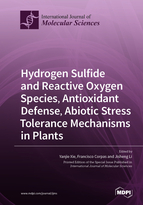Hydrogen Sulfide and Reactive Oxygen Species, Antioxidant Defense, Abiotic Stress Tolerance Mechanisms in Plants
A special issue of International Journal of Molecular Sciences (ISSN 1422-0067). This special issue belongs to the section "Molecular Plant Sciences".
Deadline for manuscript submissions: closed (31 May 2022) | Viewed by 39520
Special Issue Editors
Interests: redox balance; reactive oxygen species; hydrogen sulfide; protein persulfidation; plant drought tolerance; plant ABA signaling
Special Issues, Collections and Topics in MDPI journals
Interests: nitric oxide metabolism; signaling processes; fruit physiology; abiotic stress in crop species; ROS and RNS metabolism; melatonin; hydrogen sulfide; antioxidants
Special Issues, Collections and Topics in MDPI journals
Special Issue Information
Dear Colleagues,
Various stress conditions, such as drought, salt, heavy metals, and extreme temperatures, have severe deleterious effects on plant growth and directly lead to a decline in yield and quality. The exposure of plants to such abiotic stresses leads to the overproduction of reactive oxygen species (ROS), which are highly toxic and can cause impairment to proteins, lipids, and nucleic acids, ultimately resulting in oxidative stress. The healthy growth of plants in response to abiotic stress is inseparable from the joint action of many metabolic regulators, particularly the signaling molecules.
Hydrogen sulfide (H2S), which was previously considered to be toxic, has now been regarded as a burgeoning endogenous gaseous transmitter. H2S plays a vital role in the mechanism of response/adaptation to adverse environmental conditions as well as crosstalk with other signaling molecules, including ROS, by affecting corresponding gene expression and subsequent enzyme activities. Both H2S and ROS are potent signaling molecules that can provoke reversible and irreversible oxidative posttranslational modifications on cysteine residues of proteins such as sulfenylation or persulfidation, affecting the redox status and function of the target proteins. The dynamic interplay between persulfidation and sulfenylation occurring on cysteine residues is of great importance in response to environmental changes.
The present Special Issue of IJMS has the aim of providing the most current findings on the function of signaling molecules, including H2S and ROS, in higher plants, and it is open to different types of manuscripts, including original research papers, perspectives, or reviews where either ROS, H2S, or related molecules could be involved at biochemical or physiological levels.
Dr. Yanjie Xie
Prof. Dr. Francisco J. Corpas
Dr. Jisheng Li
Guest Editors
Manuscript Submission Information
Manuscripts should be submitted online at www.mdpi.com by registering and logging in to this website. Once you are registered, click here to go to the submission form. Manuscripts can be submitted until the deadline. All submissions that pass pre-check are peer-reviewed. Accepted papers will be published continuously in the journal (as soon as accepted) and will be listed together on the special issue website. Research articles, review articles as well as short communications are invited. For planned papers, a title and short abstract (about 100 words) can be sent to the Editorial Office for announcement on this website.
Submitted manuscripts should not have been published previously, nor be under consideration for publication elsewhere (except conference proceedings papers). All manuscripts are thoroughly refereed through a single-blind peer-review process. A guide for authors and other relevant information for submission of manuscripts is available on the Instructions for Authors page. International Journal of Molecular Sciences is an international peer-reviewed open access semimonthly journal published by MDPI.
Please visit the Instructions for Authors page before submitting a manuscript. There is an Article Processing Charge (APC) for publication in this open access journal. For details about the APC please see here. Submitted papers should be well formatted and use good English. Authors may use MDPI's English editing service prior to publication or during author revisions.
Keywords
- hydrogen sulfide
- ROS
- abiotic stress tolerance
- antioxidant defense
- persulfidation
- sulfenylation
- redox balance









